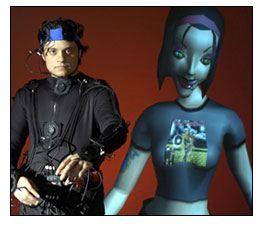PHILADELPHIA, June 25 -- The University of Pennsylvania has installed a virtual reality system that allows a participant full-body interaction with a virtual environment without the hassle of bulky, dizzying 3-D glasses.

SUITED UP: Models demonstrate the motion capture suit in front of the LiveActor screen.
Key to the installation, dubbed LiveActor, is the pairing of an optical motion capture system to monitor the body's movements with a stereo projection system to immerse users in a virtual environment. The combination lets users interact with characters embedded within virtual worlds.
"Traditional virtual reality experiences offer limited simulations and interactions through tracking of a few sensors mounted on the body," said Norman I. Badler, professor of computer and information science and director of the university's Center for Human Modeling and Simulation. "LiveActor permits whole-body tracking and doesn't require clunky 3-D goggles, resulting in a more realistic experience."
LiveActor users wear a special suit that positions 30 sensors on different parts of the body. As the system tracks the movement of these sensors as an actor moves around a stage roughly 10 feet by 20 feet in size, a virtual character -- such as a dancing, computer-generated Ben Franklin (the University of Pennsylvania's founder) -- can recreate the user's movements with great precision and without a noticeable time lag. The system can also project images onto the array of screens surrounding the LiveActor stage, allowing users to interact with a bevy of virtual environments.
LiveActor's creators envision an array of applications and plan to make the system available to companies and researchers. Undergraduates have already used LiveActor to create a startlingly realistic but completely imaginary 3-D chapel. The array could be used to generate footage of virtual characters in movies, sidestepping arduous frame-by-frame drawing. LiveActor could also help those with post-traumatic stress disorder face their fears in a comfortable, controlled environment.
"The system is much more than the sum of its parts," Badler said. "Motion capture has traditionally been used for animation, game development and human performance analysis, but with LiveActor users can delve deeper into virtual worlds. The system affords a richer set of interactions with both characters and objects in the virtual environment."
While stereo projection systems have in the past been limited to relatively static observation and navigation -- such as architectural walk-throughs, games and medical visualizations -- LiveActor can be used to simulate nearly any environment or circumstance, chart user reactions and train users to behave in new ways. Unlike actual humans, virtual characters can be scripted to behave consistently in a certain way.
LiveActor was made possible through a grant from the National Science Foundation with matching funding by the University of Pennsylvania's School of Engineering and Applied Science, as well as equipment grants from Ascension Technology Corp. and EON Reality.
For more information, visit: http://hms.upenn.edu/LiveActor/